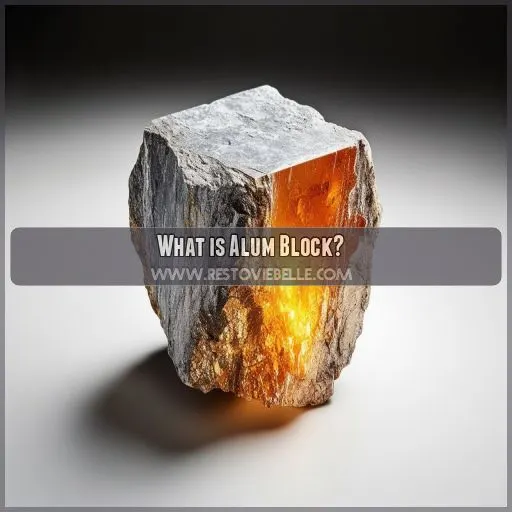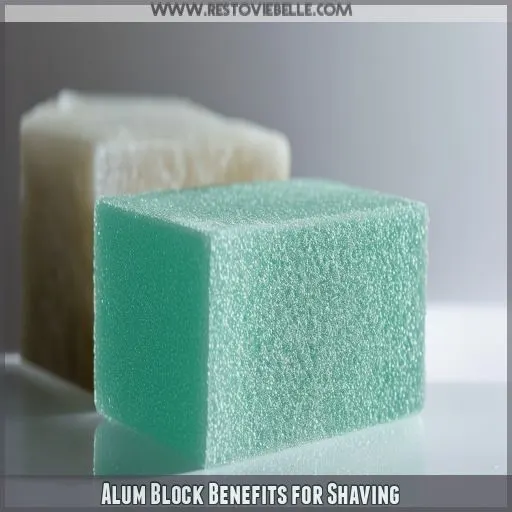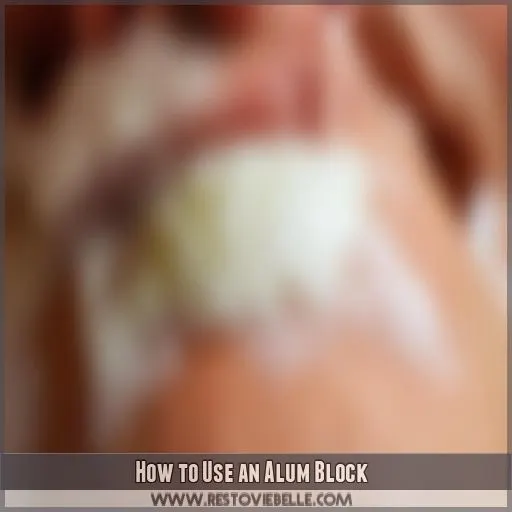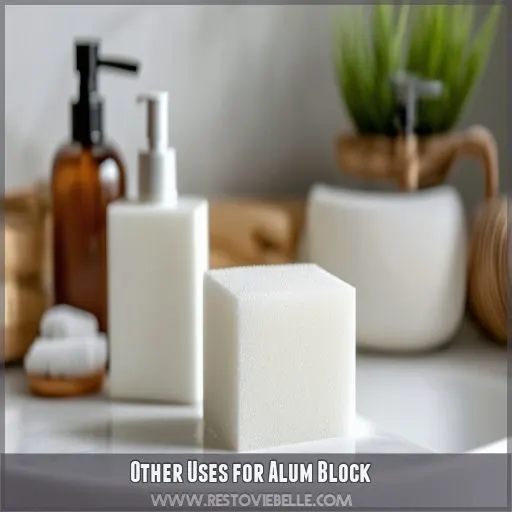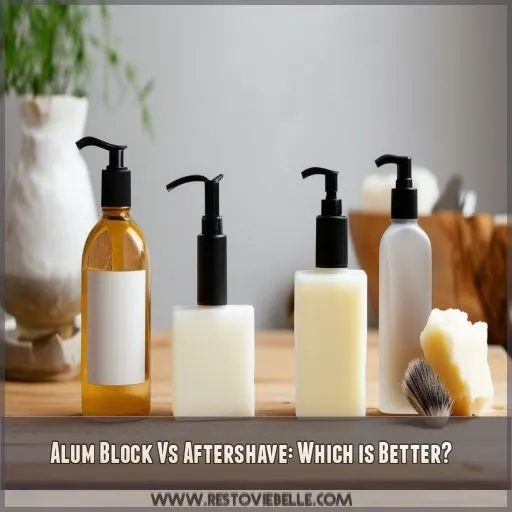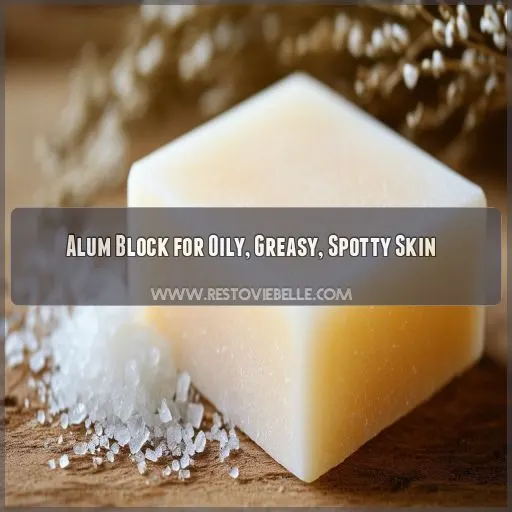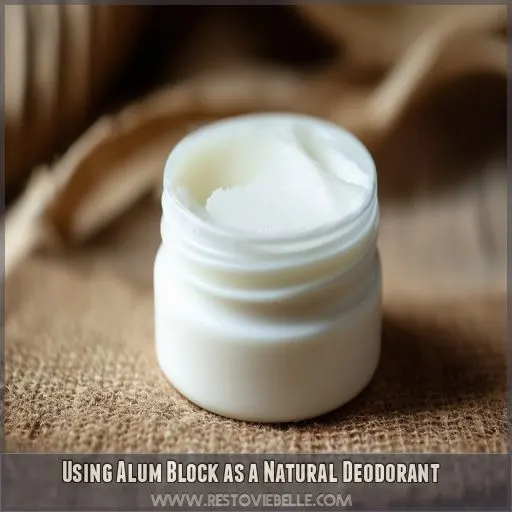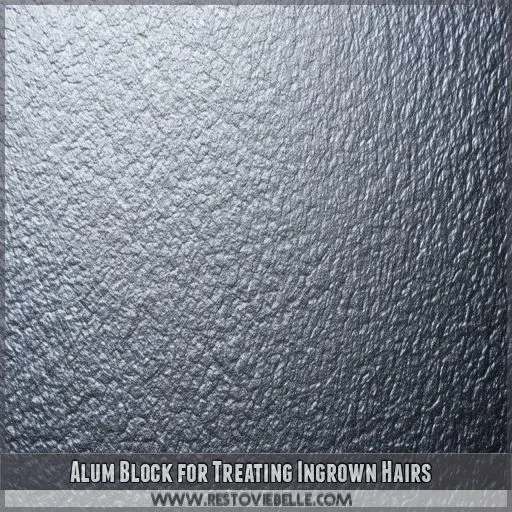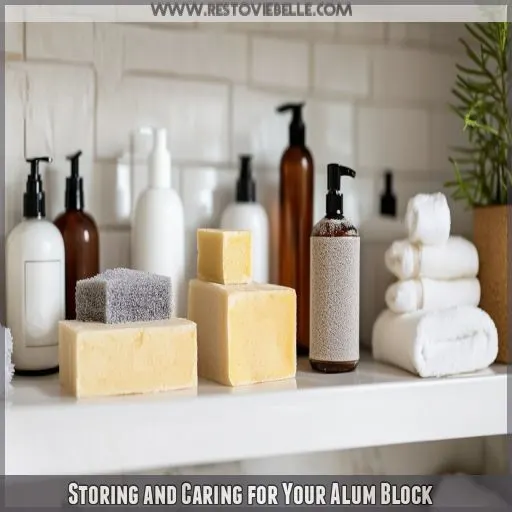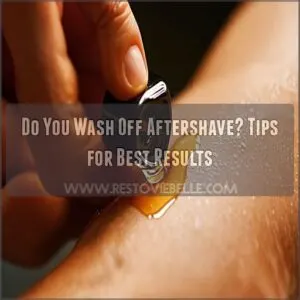This site is supported by our readers. We may earn a commission, at no cost to you, if you purchase through links.
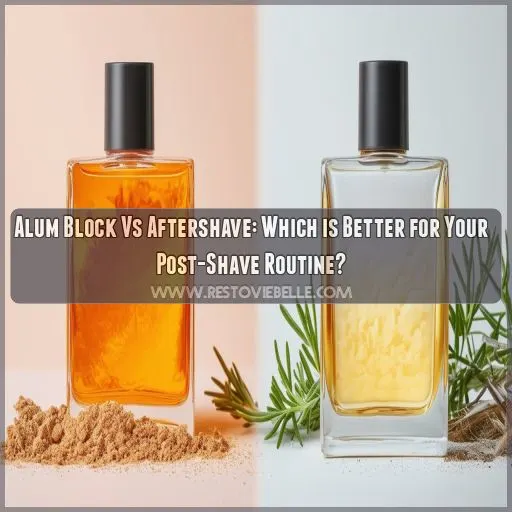 You’ll be surprised to know that 58% of men suffer from some form of post-shave irritation. Making the right choices between using an alum block versus aftershave is going to put your skincare on a high note.
You’ll be surprised to know that 58% of men suffer from some form of post-shave irritation. Making the right choices between using an alum block versus aftershave is going to put your skincare on a high note.
Alum blocks have been in use since times of yore and have antiseptic properties, cutting down those razor bumps enormously.
Aftershaves, on the other hand, are fragrant and even moisturizing, sometimes depending on the formulation. Knowledge of how either compares to the other in terms of the pros and cons of each will help you determine which one best suits your needs after shaving.
Dive in to see which option reigns supreme.
Table Of Contents
- Key Takeaways
- What is Alum Block?
- Alum Block Benefits for Shaving
- Alum Block Health Risks and Precautions
- How to Use an Alum Block
- Other Uses for Alum Block
- Alum Block Vs Aftershave: Which is Better?
- Alum Block for Oily, Greasy, Spotty Skin
- Using Alum Block as a Natural Deodorant
- Alum Block for Treating Ingrown Hairs
- Storing and Caring for Your Alum Block
- Frequently Asked Questions (FAQs)
- Is alum block good for the skin?
- Is Fitkari better than after shave?
- Does alum block prevent ingrown hairs?
- Can I use alum daily on my face?
- Can alum block prevent razor burn entirely?
- How does aftershave differ in composition?
- Does aftershave help with skin irritation?
- Are there scented alum blocks available?
- How long does the tingling sensation last?
- Conclusion
Key Takeaways
- Alum block’s antiseptic properties can help prevent razor bumps and keep your skin healthy.
- Aftershave can soothe and hydrate your skin, but some contain alcohol that can dry it out.
- Alum blocks are more eco-friendly than aftershave.
- The choice between alum block and aftershave depends on your skin type and preferences.
What is Alum Block?
An alum block is a crystal-like stone made of potassium alum, a naturally occurring mineral known for its antiseptic and astringent properties. When you shave, it can act as an effective tool to soothe the skin and stop minor bleeding, much like a styptic pencil.
To use, you simply wet the alum block and gently rub it over the shaved area, allowing it to dry briefly. Its history dates back over 2000 years, with ancient Egyptians using it for its healing properties.
Besides shaving, it’s also handy for treating spots and blackheads, functioning as a natural deodorant, and controlling excess sweating.
Alum Block Benefits for Shaving
Alum block offers impressive antiseptic properties that can help stop bleeding from minor nicks and cuts after shaving. Its benefits for reducing razor bumps and soothing irritated skin make it a valuable addition to your post-shave routine.
Antiseptic Properties Overview
Alum block is considered to have antiseptic properties that keep your skin from getting infected after a shave. Potassium alum is essentially antimicrobial in nature, counteracting skin irritation like razor burns, making it the best aftershave to keep your skin fresh and cool.
Benefits for Razor Bumps
Using an alum block can greatly reduce razor bumps. Here’s why:
- It tightens pores, preventing ingrown hairs.
- Its antiseptic properties combat infection.
- It soothes irritation immediately.
- Effective for all skin types, providing instant relief.
Application Instructions
To use an alum block, wet it with cold water, gently rub it onto your freshly shaved skin, let it dry for 15-20 seconds, then rinse and apply moisturizer.
| Step | Instructions |
|---|---|
| 1 | Wet the alum block with cold water |
| 2 | Gently rub the block over your shaved skin |
| 3 | Allow the residue to dry for 15-20 seconds |
Alum Block Health Risks and Precautions
Apart from the many benefits associated with an alum block, several health risks and precautions have to be understood. While there are some reports of allergic reactions that may cause sensitivity and in some rare cases even skin irritation, keep in mind that in most cases:
- Drying Effects: Alum is able to suck out moisture from your skin and can dry it out, especially if you have dry skin.
• Skin Sensitivity: A tingling, stinging, or burning sensation is quite normal but should fade out rather quickly. Persistent discomfort may indicate a problem.
- Medical Consultation: If the irritation persists or you suspect you’re having an allergic reaction, then see a doctor or other qualified healthcare professional.
• Allergy Avoidance: If you’re allergic to alum, don’t use the block at all, since this can cause some adverse reactions.
How to Use an Alum Block
Using an alum block isn’t that hard and has loads of benefits if included in one’s after-shaving routine. Here is how to make the process work best:
- Wet the Alum Block: Wet the alum block in cold water after shaving.
- Application: Gently glide the block across your shaved areas. You might feel a bit of tingling, but this again is simply the mineral salts doing their thing.
- Dry and Rinse: Drop it on the skin for approximately 15–20 seconds before washing off with cold water.
Remember to apply a moisturizer afterwards, because it dries the skin. There are alternatives to alum block on the market, but nothing works like an alum block for soothing razor bumps and tightening pores.
Other Uses for Alum Block
Beyond its shaving benefits, alum block has a variety of other practical uses. Its antiseptic and astringent properties make it an excellent natural remedy for acne, helping to dry out blemishes and tighten pores. Simply rub the damp block over affected areas to help kill bacteria and reduce inflammation.
Alum block can also serve as a natural deodorant, as its mineral salts inhibit the growth of odor-causing bacteria. For those who wax, applying alum block to the skin afterward can soothe irritation and redness. With its versatility and gentle, non-toxic formula, alum block is a must-have addition to any natural skincare routine.
Alum Block Vs Aftershave: Which is Better?
Now, if one had to choose between an alum block and aftershave, a few things should be noted. Both of these products have their own benefits; it’s hence most likely that the choice will be made based on personal preference and needs.
- Alum Block Safety: All the compounds of an alum block are natural, including mineral salts. They’re safe for the skin, bar very few cases of allergies.
- Aftershave Preference: After shaves usually contain fragrances and alcohol that provide a refreshing feel to the skin surface after shaving.
- Cost Comparison: Alum blocks are less costly and last longer than liquid aftershaves.
Eco-friendliness: Alum blocks are more eco-friendly due to minimal packaging.
- Personal Experience: Some find that alum blocks are soothing immediately for razor bumps, while others enjoy the fragrance or feel of aftershave.
Alum Block for Oily, Greasy, Spotty Skin
Moving off the aftershave debate, let’s get into why I use an alum block for oily, greasy, and spotty skin.
The mineral salts of the alum block may very well be this secret weapon against skin issues. When applied, tightening your skin, it helps reduce the appearance of oiliness, fighting blackheads and even razor bumps.
Wet the block with cold water and gently rub over the affected area. You may feel a bit of a tingle, but that’s normal; it only means it’s working.
The key lies in the consistency—just keep using it on a regular basis to ward off skin irritation and reveal clearer, healthier-looking skin.
Using Alum Block as a Natural Deodorant
Using an alum block as a natural deodorant is basic yet very effective. In fact, the ancient crystal doesn’t just act as an antiperspirant to lessen sweat but also diminishes body odor while lessening skin irritation. Here are the steps for its usage:
- Wet the block: Wet the block with cold water.
- Apply to skin: Gently apply to clean, dry underarms.
- Allow to dry: Allow the residue to sit and dry on its own.
- Daily use: Used every day for continuous odor reduction and refreshingly lasting freshness.
Alum Block for Treating Ingrown Hairs
Dealing with ingrown hairs and razor bumps can leave you feeling frustrated, especially if you have sensitive skin. While alum block’s natural deodorant properties are a bonus, its real magic shines in treating ingrown hairs. Alum block’s antiseptic properties can alleviate skin irritation and prevent infection, making it an effective, alternative treatment. When used post-shave, alum block tightens skin and reduces redness, promoting smoother skin and minimizing further ingrown hairs.
| Ingrown Hairs | Razor Bumps | Skin Irritation | Sensitive Skin |
|---|---|---|---|
| Reduced | Less visible | Alleviated | Suitable |
| Controlled | Minimized | Prevented | Gentle |
| Healed faster | Soothed | Reduce risk | Safe |
To summarize, alum block isn’t just a post-shave necessity but also a remedy for ingrown hairs.
Storing and Caring for Your Alum Block
Proper storage and care will help your alum block last for years. After each use, simply rinse the block under cool water and pat it dry with a clean towel. Allow it to fully air-dry before storing it in a cool, dry place.
An airtight container or resealable bag works great to keep dust and moisture away. With proper care, your alum block can maintain its potency for up to 5 years.
When traveling, wrap the block in a soft cloth to protect it from damage. Avoid exposing the alum to extreme heat or humidity, as this can cause it to dissolve prematurely.
Frequently Asked Questions (FAQs)
Is alum block good for the skin?
Yes, an alum block benefits your skin by reducing inflammation, soothing irritation, and preventing razor bumps. It’s a natural antiseptic that tightens pores and stops minor bleeding, though it may cause mild irritation for some.
Is Fitkari better than after shave?
Fitkari, with its antiseptic and antibacterial properties, can effectively manage razor bumps, cuts, and shaving irritation. However, it can cause dryness and irritation, whereas aftershave often provides added moisture along with soothing benefits (Source).
Does alum block prevent ingrown hairs?
The alum block is like the Swiss Army knife of wet shaving: it seals nicks, soothes irritation, and even helps fend off pesky ingrown hairs. Unlock the way to smoother, healthier skin with this Versatile Mineral Marvel.
Can I use alum daily on my face?
You can use an alum block daily on your face, but be cautious. It can dry out your skin, so always follow up with a good moisturizer. If irritation occurs, reduce usage or consult a dermatologist.
Can alum block prevent razor burn entirely?
Although an alum block does tighten the pores, working as an antiseptic and fighting razor burn, it isn’t going to totally eliminate the problem since proper shaving technique and good skin care practices are equally important.
How does aftershave differ in composition?
Aftershave typically contains 60% alcohol, which can dry out skin. In contrast, alum block’s mineral salts constrict blood vessels, tighten pores, and control excess sweating – making it a gentler post-shave option.
Does aftershave help with skin irritation?
Yes, aftershave can help with skin irritation by soothing and hydrating the skin. It usually contains antiseptics and moisturizers that reduce redness, calm post-shave burn, and prevent infections, leaving your skin feeling refreshed.
Are there scented alum blocks available?
You won’t find scented alum blocks as they’re typically natural and fragrance-free. However, their compatibility with any aftershave or moisturizer allows you to enjoy your preferred scent post-shave.
How long does the tingling sensation last?
Ah, the tingling sensation – nature’s way of reminding you that you’re alive! Fear not, dear user, as this tingly tingle typically subsides within a minute or two. Embrace the zing and bask in the glory of your freshly soothed skin!
Conclusion
It’s ironic that something as simple as choosing between an alum block and aftershave can have a big impact on your post-shave routine.
When weighing the pros and cons, consider your skin type and specific needs. Alum blocks are unparalleled for their antiseptic properties and combatting razor bumps.
On the other hand, aftershaves often provide fragrance and moisture.

